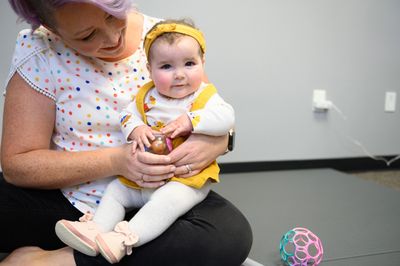Signed in as:
filler@godaddy.com
Signed in as:
filler@godaddy.com
Cuevas Medek Exercises (CME) is a specialized hands-on physiotherapy approach designed for infants and children with developmental delays.
This psychomotor therapy focuses on the connection between the brain and the body, leveraging neuroplasticity—the brain’s incredible ability to adapt, recover, and form new neural pathways.
The hallmark of CME is its focus on helping children develop automatic motor responses by working against gravity. During each session, a trained physiotherapist carefully positions the child to challenge their body to react and adjust independently. As these reactions are practiced, the brain forms new neural connections, increasing the likelihood of repeating these movements over time.
The ultimate goal of CME is to help children develop functional motor control and achieve greater independence in head and trunk control, sitting, standing, and walking.


While Dynamic Movement Intervention (DMI) and CME look very similar on the surface, they are in fact different. CME prioritizes the quality and refinement of exercises and encourages children to work towards improving alignment. DMI prioritizes alignment and uses additional equipment such as knee immobilizers, theratogs or estim to achieve alignment within the exercises.
It isn’t uncommon for children to cry at times during CME, especially the first few sessions. We are asking them to do something hard and they are communicating with us. We prioritize making a connection so that the child and therapist can build a relationship built on trust and support, over time most children settle. We always provide time for cuddles with parents and regulation.
CME is carefully designed to meet your child where they are in their development. While it does challenge children to work against gravity and develop new motor responses, the exercises are tailored to their abilities and progress at a pace that is appropriate for them.
The goal of CME is to gently push your child toward functional movement while building their confidence and resilience. Our trained physiotherapists ensure each session is engaging, supportive, and motivating, making the process both effective and enjoyable.
Some children may initially find the exercises unfamiliar, but as they gain strength and coordination, they often adapt quickly and thrive. We also work closely with families to ensure everyone feels confident and supported throughout the process.
Total Motion Release (TMR) Tots is an innovative and gentle approach to pediatric physiotherapy that focuses on improving your child’s movement patterns and overall function. Unlike traditional therapies that directly target areas of concern, TMR works by identifying and addressing areas of the body with better mobility and strength to help naturally balance and improve areas with limitations.


TMR can be tailored to children with a wide range of developmental or physical challenges, from mild to complex.
Yes, in fact TMR works best when done daily. Our priority is to empower parents to be the primary treatment provider with our support.
Traditional physiotherapy often focuses on directly addressing areas of the body that are tight, weak, or not functioning as expected. This can sometimes involve stretching tight muscles to improve range of motion. While this approach can be effective, in children, repeated traditional stretching has the potential to create microtears in tight muscles, which may lead to discomfort or delayed progress.
Total Motion Release (TMR) takes a different and more holistic approach. Rather than focusing on the tight or restricted areas, TMR identifies areas of the body that already move well and uses specific, guided movements to enhance these strengths. This creates a ripple effect throughout the body, allowing restricted areas to release naturally and balance to be restored without overstressing tight muscles.
The Hypervibe is a whole-body vibration platform used in physiotherapy to help children improve strength, balance, coordination, and regulate muscle tone. This specialized tool delivers controlled vibrations to stimulate the body’s muscles and nervous system, enhancing movement and development.


For our children with high or low tone, we frequently start the session on the hypervibe and than transition into other exercises such as CME
While the Hypervibe is a versatile and effective tool, it may not be suitable for every child. The Hypervibe may not be appropriate for children with acute injuries, such as recent fractures or muscle tears. Additionally, children with certain medical conditions like uncontrolled epilepsy, severe cardiovascular issues, or implanted medical devices (e.g., pacemakers; rods or screws) may not be candidates for vibration therapy. Those with conditions affecting bone health, such as severe osteoporosis may not be appropriate. Finally, children with heightened sensory sensitivities might find the vibrations overwhelming, although adjustments can often be made to accommodate them.
Yes there is! Research shows the whole body vibration can improve strength/power, increase bone mineral density/bone mass, impact motor-neuron excitability and improve muscle function in children. One study showed improvement in spasticity and walking motor pattern in children with CP.
At Erin Memering Pediatric Physio, we use the Hypervibe WBV platform as a safe and effective way to complement therapy. While it’s not a standalone treatment, it’s a powerful addition to help children achieve their physical goals more effectively. If you’re curious, we’re happy to share more about the studies and explain how WBV might support your child’s progress!

We use cookies to analyze website traffic and optimize your website experience. By accepting our use of cookies, your data will be aggregated with all other user data.